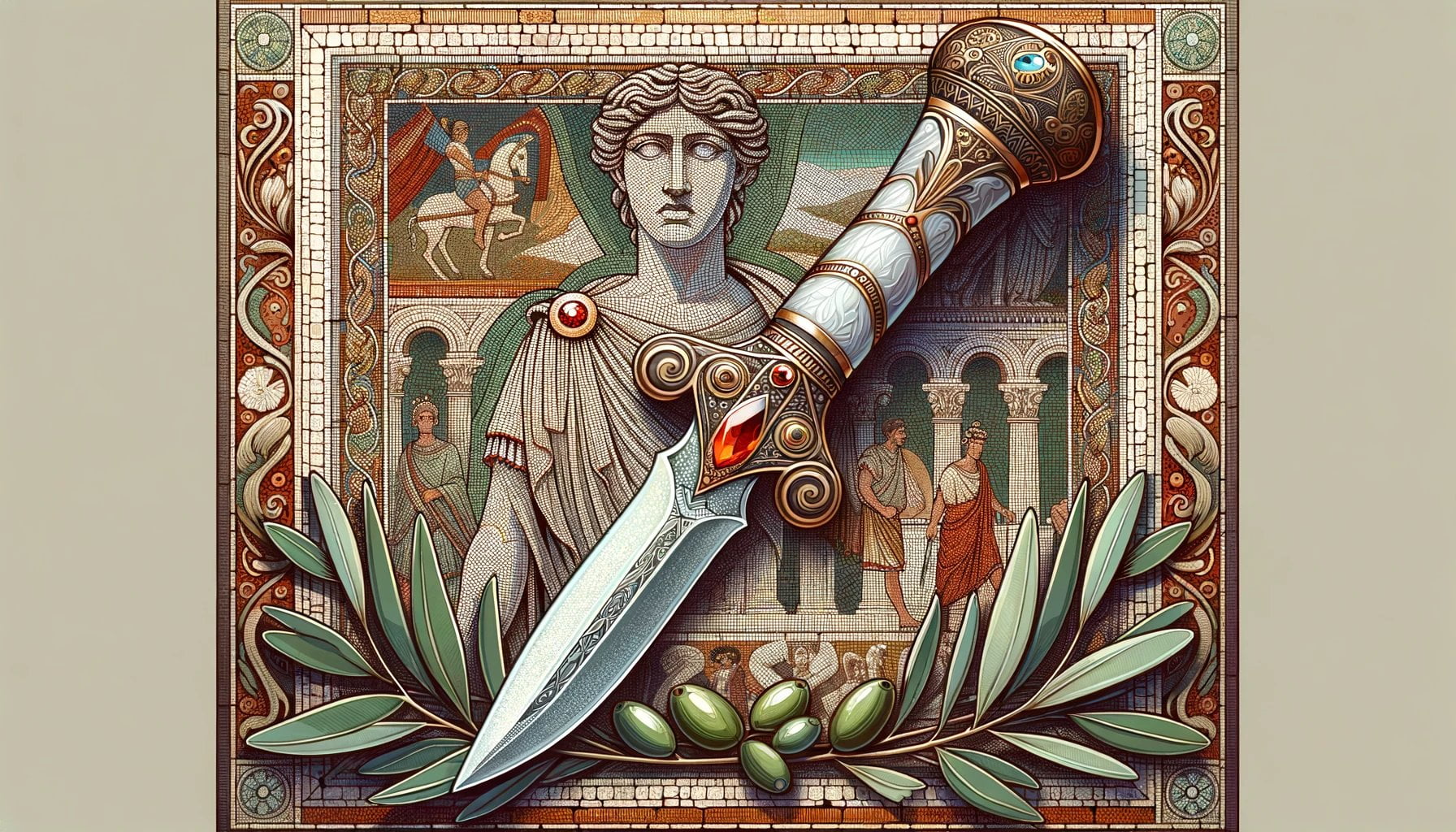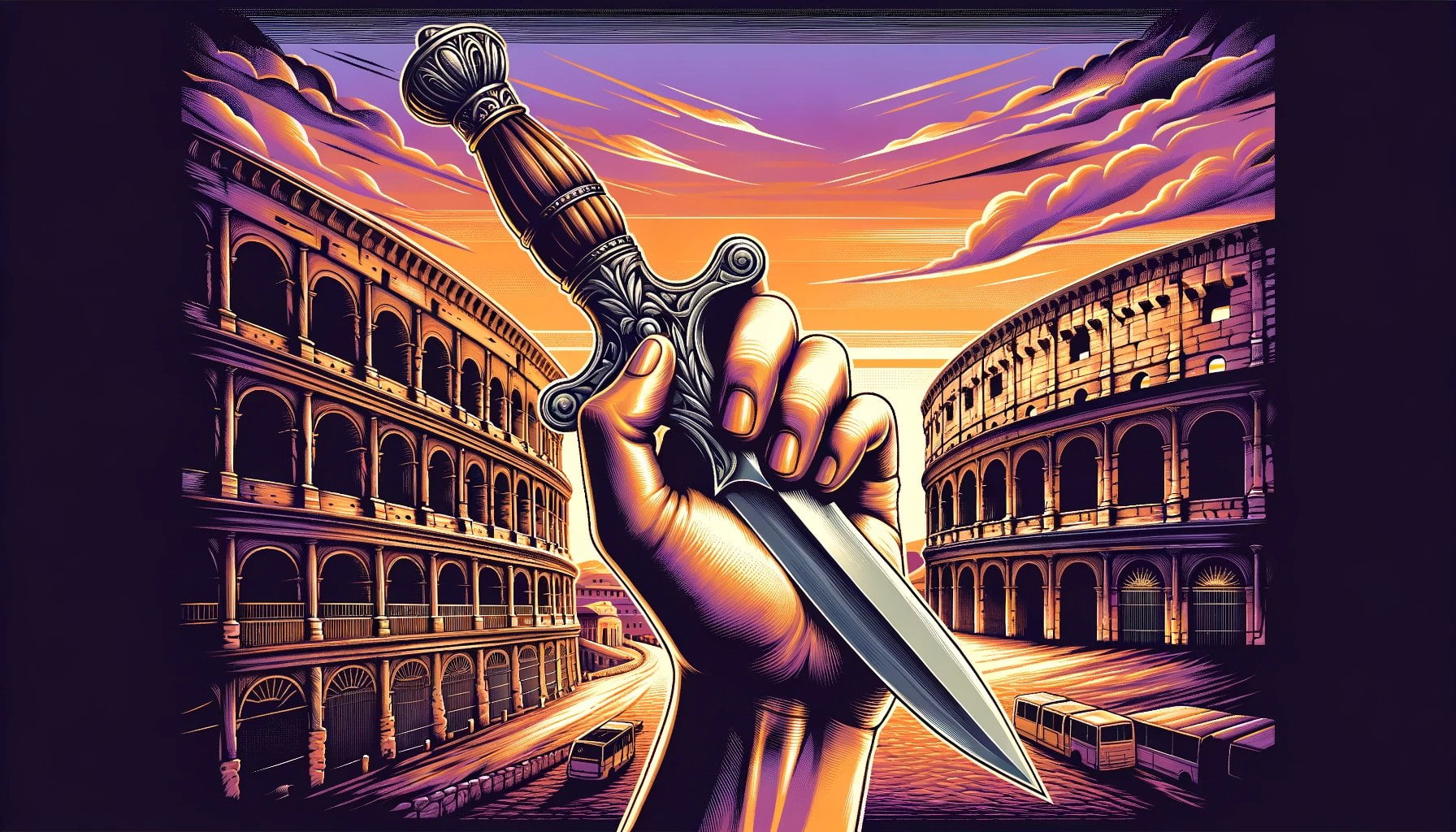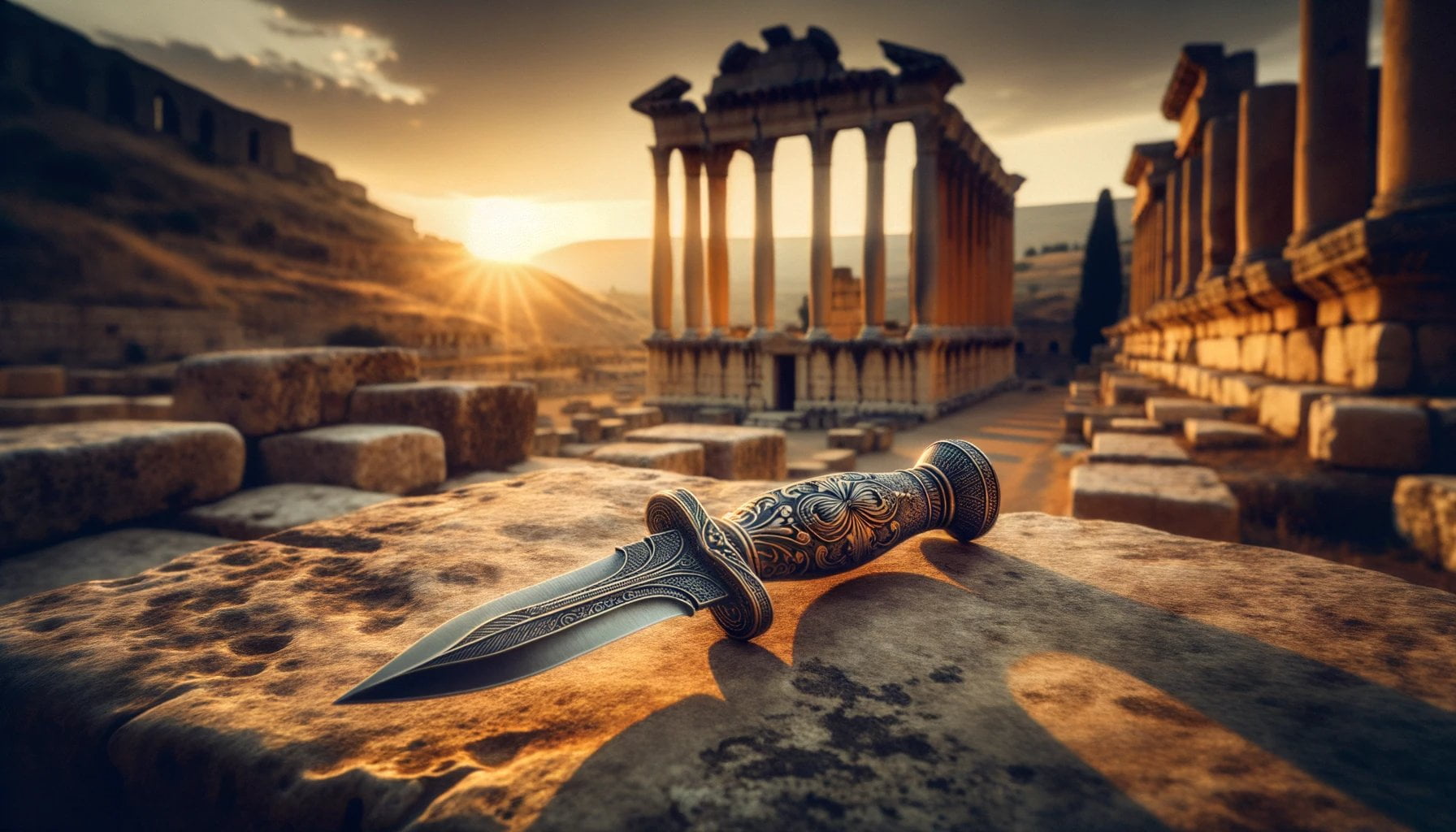Unveiling Roman Daggers: Exploring Ancient Rome’s Intriguing Weaponry takes readers on a captivating journey into the world of ancient Roman weapons. Delving into the rich history and culture of Ancient Rome, this article offers a comprehensive exploration of the significance and craftsmanship behind Roman daggers. As an archaeologist with a deep passion for uncovering fascinating artifacts, this article showcases my expertise in unearthing captivating relics that shed light on the enigmatic past. With over a decade of experience in excavations across various Roman sites, my extensive research and meticulous analysis provide readers with an engaging and informative insight into the intricacies of these remarkable weapons.

Key Takeaways:
- The pugio dagger was a secondary weapon used by Roman soldiers, typically worn on the left side of the body and attached to the cingulum.
- It had a blade length between 17.7 inches and 19.7 inches, with variations featuring a leaf-shaped blade or a small triangular tip.
- The pugio dagger was not ideal for general use and was likely used for more ornate purposes.
- Roman soldiers also carried the gladius hispaniensis, a Spanish sword, as their main weapon.
- Initially, the pugio dagger was worn on the right hip alongside the gladius on the left, but this changed around the 3rd century BCE after the wars with Carthage.
- The pugio dagger was commonly used for assassination and acts of suicide, and it was favored by conspirators like those who stabbed Julius Caesar.
- Officials of the Roman Empire also wore the pugio dagger as a concealed defense weapon.
- An amateur archaeologist in Switzerland discovered a 2,000-year-old Roman dagger in remarkable condition, inlaid with silver and brass.
- The dagger was intentionally buried, possibly as a token of thanks after a victory in battle.
Ancient Rome Dagger
In the vast tapestry of ancient Rome’s history and culture, one artifact that shines a light on the enigmatic past is the intriguing ancient Rome dagger. These weapons, known as pugio daggers, were a significant part of Roman soldiers’ equipment and played a role beyond mere functionality.
The Pugio Dagger: An Ornate Secondary Weapon
The pugio dagger was an ornate weapon used by Roman soldiers as a secondary armament. Worn on the left side of the body and attached to the soldier’s cingulum, this dagger boasted a blade length ranging from 17.7 inches to 19.7 inches. Some variations featured a leaf-shaped blade, while others had a small triangular tip. While not designed for general use, the pugio dagger served more ornate purposes.
A Companion to the Gladius Hispaniensis
The main weapon of the Roman army was the gladius hispaniensis, a Spanish sword. Interestingly, the pugio dagger was typically worn on the right hip alongside the gladius on the left. This arrangement changed around the 3rd century BCE after the wars with Carthage.
Assassination, Suicide, and Concealed Defense
The pugio dagger had a dark side to its reputation. It was often utilized for acts of assassination and suicide. Conspirators, such as those responsible for the infamous stabbing of Julius Caesar, frequently wielded this dagger. Additionally, officials of the empire would wear the pugio as a concealed defense weapon, ready to protect themselves if the need arose.
New Discoveries: Unearthing a 2,000-Year-Old Roman Dagger
In a recent discovery, an amateur archaeologist in Switzerland uncovered a remarkably well-preserved 2,000-year-old Roman dagger. This exquisite piece of history was inlaid with silver and brass, showcasing the remarkable craftsmanship of the time. It was buried intentionally, potentially as a token of thanks after a victorious battle.
Unveiling Ancient Rome’s Intriguing Weaponry
With its rich historical significance and captivating craftsmanship, the ancient Rome dagger, specifically the pugio, provides us with a glimpse into the fascinating world of one of history’s most renowned civilizations. Its dual role as an ornate secondary weapon and a symbol of power and secrecy sets it apart. From assassination to self-defense, the pugio dagger played a critical part in the fabric of ancient Roman society.
Continued explorations and discoveries promise to uncover even more insights into the mysteries behind these remarkable ancient weapons. As we delve deeper into the timeless allure of ancient Rome’s weaponry, we unlock a deeper understanding of the culture and legacy left behind by this remarkable civilization.
Check out our page on the important people in ancient Rome, to learn more about the influential figures who shaped this historic civilization. Click here to explore.
Discover the fascinating history behind the black origins of ancient Rome and how diverse cultures contributed to its rich heritage. Dive into this captivating topic by clicking here.
Uncover the secrets of the ancient Rome weapons, and delve into the sophisticated war strategies employed by this ancient empire. Click here to embark on a journey through history.
Explore the innovative insulae architecture of ancient Rome, which revolutionized urban living during its time. Click here to discover more about these groundbreaking structures.
Significance and Symbolism of Roman Daggers in Ancient Rome
The pugio dagger, a staple in the Roman army’s arsenal, held significant meaning and symbolism in Ancient Rome. This article delves into the intricacies of these ancient weapons, exploring their historical significance, craftsmanship, and the cultural impact they had on the Roman Empire.
Roman daggers, such as the pugio, were not only functional weapons but also powerful symbols of authority and defense. Worn by Roman soldiers as a sidearm, these daggers represented the soldiers’ readiness to protect themselves and the empire. Furthermore, these daggers were commonly worn by officials of the empire, accentuating their status and power.
The pugio dagger played a pivotal role in Roman history, finding itself entangled in acts of assassination and suicide. Its double-edged blade and well-crafted handle, typically measuring 7 to 12 inches and 4 inches long, respectively, made it an effective tool for close-quarter combat.
Beyond its practical application, the pugio dagger symbolized the precarious balance between life and death. Its presence served as a reminder of the immense power held by the Roman Empire and the potential downfall that lay in its hands. The dagger’s symbolism extended to personal virtues as well, representing the Roman soldier’s ability to overcome adversity, take risks, and face challenges head-on.
Archaeological discoveries have shed light on the craftsmanship and design of these ancient daggers. Through detailed analysis, historians have uncovered the different variations and styles of pugio daggers, their ornate detailing, and intricately crafted sheaths. These findings enhance our understanding of ancient Roman culture and provide insights into the legacy left behind by this fascinating civilization.
Key Takeaways:
– Roman daggers, specifically the pugio, held immense significance and symbolism in Ancient Rome.
– They were worn by Roman soldiers as a sidearm, representing their readiness to defend themselves and the empire.
– The pugio dagger was also worn by empire officials, highlighting their status and power.
– These daggers played a role in acts of assassination and suicide, reflecting the power of life and death.
– The pugio dagger symbolized the potential downfall of empires and represented personal virtues such as overcoming adversity and facing challenges head-on.
– Archaeological discoveries have provided insights into the craftsmanship and design of Roman daggers, further enriching our understanding of ancient Roman culture.
Various Types of Roman Daggers and Their Purposes
Roman daggers played a crucial role in the weaponry of Ancient Rome. They served different purposes and were wielded by soldiers, officials, and even assassins. Let’s dive into the intriguing world of Roman daggers and explore their various types and purposes.
Gladius: The Primary Weapon for Foot Soldiers
The gladius was the go-to weapon for foot soldiers in Ancient Rome. Its name derived from “gladiator,” meaning swordsman, and “gladiolus,” meaning little sword. With a double-edged blade that excelled in thrusting, the gladius was a versatile weapon used in close combat situations[^1^].
Pugio: A Versatile Weapon for Close Combat and More
The pugio, a long thrusting dagger, was issued to Roman soldiers. Its purpose extended beyond close combat, as it was also used for assassination and even suicide[^1^]. In fact, conspirators who assassinated Julius Caesar used pugiones to stab him[^2^]. This highlights the unique role of the pugio as both a weapon and a tool for self-destruction.
Parazonium: A Symbol of Rank and Authority
The parazonium was a short sword or dagger reserved for Roman generals and emperors. It represented their rank and authority, serving as a symbol of power. This distinguished weapon showcased their elite status within the Roman military hierarchy[^1^].
Spatha: A Long Sword for Extended Reach
When the gladius fell out of favor, the spatha took over. It was essentially a longer version of the Pompeii gladius, featuring a long, narrow, and straight blade. With its extended reach, the spatha became a favored weapon among Roman soldiers[^1^].
These four types of Roman daggers offer a glimpse into the diverse range of weapons used by soldiers and officials in Ancient Rome. From the versatile gladius to the symbolic parazonium, each dagger had its own unique purpose and significance.
Key Takeaways:
- The gladius was a primary weapon for foot soldiers, known for its thrusting capabilities.
- The pugio dagger served as a versatile weapon used for close combat, assassination, and even suicide.
- The parazonium was a short sword or dagger exclusively wielded by Roman generals and emperors, symbolizing their rank and authority.
- The spatha was a long sword that replaced the gladius and provided soldiers with extended reach.
Sources:
1. blog.knife-depot.com
2. buyingasword.com
Legacy and Impact of Roman Daggers on Warfare and Culture
Archaeological excavations have offered us a fascinating glimpse into the past, unveiling the legacy and impact of Roman daggers on both warfare and culture. These ancient weapons played a crucial role in the Roman Empire, influencing not only military strategies but also symbolizing power and authority.
Roman Daggers: Varied Purposes and Users
Roman daggers were not limited to a single purpose or user. They served different functions, being wielded by soldiers, officials, and even assassins. Let’s explore some of the prominent types of Roman daggers:
- The Gladius: The Foot Soldier’s Companion
The gladius, with its double-edged blade and versatile nature, was the primary weapon for Roman foot soldiers. This short sword was expertly crafted and designed for close combat situations, allowing soldiers to deliver swift and deadly strikes.
- The Pugio: A Dagger of Multiple Meanings
Issued to Roman soldiers, the pugio was a long thrusting dagger. While commonly used in close combat like the gladius, it also had a darker side. The pugio was notorious for its association with acts of assassination and suicide. It represented the delicate balance between life and death, revealing the complex nature of Roman culture.
- The Parazonium: Symbol of Rank and Authority
Exclusively reserved for Roman generals and emperors, the parazonium stood as a symbol of their prestigious rank, authority, and elite status. This short sword or dagger showcased the power and dominance of those who wielded it, making it an iconic weapon in Roman society.
- The Spatha: An Extended Reach
Replacing the gladius, the spatha was a long sword favored by Roman soldiers. Unlike its predecessor, the spatha boasted an extended reach, allowing soldiers to engage enemies from a greater distance. This innovation in weaponry showcased the Romans’ continuous desire for improvement and adaptability.
Exploring the Impact
Roman daggers went beyond their primary functions as weapons, leaving a lasting impact on both warfare and culture. Let’s delve into the significance of these ancient weapons:
- Symbolism and Authority: In ancient Rome, daggers like the pugio and parazonium symbolized authority and defense. They were worn by Roman soldiers as a sidearm, representing their readiness to protect themselves and the empire. Additionally, empire officials donned these daggers, emphasizing their status and power.
- Innovation and Adaptation: The development and refinement of Roman daggers showcased the Romans’ advancements in craftsmanship and design. These weapons were not only effective for combat but also exemplified the Romans’ dedication to innovative solutions in warfare.
- Cultural Significance: Roman daggers played a role in shaping Roman culture and values. They were associated with virtues such as overcoming adversity, as they embodied the potential downfall of empires. The symbolism behind these daggers provided insight into the Roman mindset and their interpretation of power and mortality.
- Archaeological Discoveries: The excavation of Roman daggers has offered valuable insights into ancient Roman culture and craftsmanship. Detailed analysis of these artifacts has shed light on the techniques employed by Roman artisans and the materials used, further enhancing our understanding of the time period.
Key Takeaways:
- Roman daggers, including the gladius, pugio, parazonium, and spatha, had various purposes and users within the Roman Empire.
- These weapons symbolized authority, defense, and the delicate balance between life and death.
- Roman daggers showcased the Romans’ commitment to innovation and adaptation in warfare.
- The cultural significance of Roman daggers revealed insights into Roman values, mindset, and interpretation of power.
- Archaeological discoveries surrounding Roman daggers have deepened our understanding of ancient Roman culture and craftsmanship.
*Citation:
– World History Encyclopedia – Ancient Roman Civilization
– Business Insider – 2,000-year-old dagger discovered in Switzerland

FAQ
Q1: What is a pugio dagger and how was it used in Ancient Rome?
A1: The pugio dagger was an ornate weapon used by Roman soldiers as a secondary weapon. It was typically worn on the left side of the body and attached to the soldier’s cingulum. The pugio had a blade length between 17.7 inches and 19.7 inches, and it was primarily used for close combat, assassination, and acts of suicide.
Q2: What other types of daggers were used in Ancient Rome?
A2: In addition to the pugio dagger, there were several other types of Roman daggers. The gladius, which was the primary weapon for foot soldiers in Ancient Rome, the parazonium, which was a short sword or dagger used by Roman generals and emperors as a symbol of their rank and authority, and the spatha, which was a longer version of the gladius, were among the most notable types of Roman daggers.
Q3: What was the significance of the pugio dagger in Ancient Rome?
A3: The pugio dagger held symbolic significance in representing power and defense. It was commonly worn by officials of the empire as a concealed defense weapon. The dagger also played a role in assassinations and acts of suicide, making it a weapon with a dual purpose in Ancient Rome.
Q4: How did the pugio dagger differ from other Roman daggers?
A4: The pugio dagger was characterized by its long, thrusting blade and was typically used for close combat. Unlike the gladius or the spatha, it was not the main weapon of Roman soldiers but served as a secondary weapon. The pugio dagger was also known for its ornate design, often inlaid with silver and brass.
Q5: Are there any notable archaeological discoveries related to Roman daggers?
A5: Yes, there have been several archaeological discoveries related to Roman daggers. Recently, an amateur archaeologist in Switzerland unearthed a 2,000-year-old Roman dagger in remarkably good condition. This discovery provided insight into a forgotten battle between Roman legions and tribal warriors, and the dagger itself was inlaid with silver and brass, possibly buried intentionally as a token of thanks after a victory in battle.
- Unveiling the Enigma: Mansoureh Khojasteh Bagherzadeh’s Public Appearances & Private Life in Iran - July 18, 2025
- Unveiling the Mystery: Mansoureh Khojasteh Bagherzadeh’s Husband: A Rare Glimpse into a Private Life - July 18, 2025
- Unveiling Masoud Khamenei’s Mother: Power, Influence, and Iran’s Future - July 18, 2025
















